Kitchen Project #113: The Art of Meringue ft. The Plinth Pavlova
Let's go down the dessert rabbit hole.
Hello,
Welcome to today’s edition of Kitchen Projects, my recipe development journal. Thank you so much for being here!
Today we’re diving into the sculptural world of meringue, with a journey through food trends and the history of dessert whilst we are at it. While this newsletter is more about inspiration and how to create your own dessert concepts, I’m thrilled to share my recipe and how-to my the Plinth-lova for KP+ subscribers: A completely edible ancient Roman/Greek esque plinth (that stands up on its own!) featuring a still-life fruit display on top. I’ve LOVED making this one.
What’s KP+? Well, it’s the level up version of this newsletter. By joining KP+, you will support the writing and research that goes into the newsletter (including the commissioning - and fair payment - of all the writers) and join a growing community, access extra content (inc. the full archive) and more. Subscribing is easy and only costs £5 per month. Why not give it a go? Come n join the gang!
Love,
Nicola
For the love of frou-frou desserts
One of the things I love most about dessert is the way I get so utterly wooed by it. I know we're not supposed to judge a book by its cover, but even Greggs knows the power of a sprinkle and some brightly coloured icing atop a doughnut. Give me the old razzle dazzle. Hook, line and sinker, I’m IN.
Though fancy restaurants will give every course this ultra aesthetic treatment - wedges of duck appear as sparse Scandi interiors, vegetables are moulded into abstract objects - most restaurants will leave their most imaginative plating for the final course. It's often where the fun (and colour) lives; I mean, there's a reason that Willy Wonka owned a chocolate factory and not a meat processing facility.
Some restaurants take a comparatively austere approach to dessert, but I'm always deeply romanced by the most unashamedly frou-frou finishes. From the ice cream served in a plastic penguin at our favourite Chinese restaurant growing up, to the intentional placement of a maraschino cherry or two, to those (loveably stupid) chocolate spheres that are melted in front of you with salted caramel sauce at questionably expensive steak houses, I love them all.
I have plenty of memories of great meals out, but it’s the sweets and desserts that have really punctuated my life; I mean, cake is the reward we get for living another year! Of course, I'm sure we all know at least one person who makes 'hating sweet things' a part of their personality, and I have learnt to accept that some people *really do want* a cheese tower sweating away in the corner of their wedding, but when it comes down to it, even they have to admit a slice of birthday cake in the shape of a caterpillar can be hard to resist.
Pretty Pavlova
One dessert that never lets me down in the frou-frou department is the always-gilded pavlova (my classic recipe & deep dive here). Appearing as great poofy ballgowns or flat wide clouds, they are a delightful canvas for piles of fresh fruit. Cake adjacent, they make a resplendent celebratory bake and are met with just as many (if not more) 'oohs' and 'ahhs'. Though I always used to think pavlova was a summer thing, I’m pretty sure its a format we should make the most of year round.
Recently, the pavlova has been having a makeover – see this recent brilliant piece in Vogue by the lovely Lauren Joseph - and though I do love the classic shape and look, I'm delighted with the new forms it has taken. Though social media definitely has its downsides, I'm grateful for the constant exposure to the expansive creative network that is the global baking, food styling & pastry chef community!
A new shape?
As summer was coming into focus earlier this year, I was suddenly struck with inspiration: Meringue Columns. Greek Ionic columns, to be exact, piped and baked and used as décor, a blend of classic design with modern techniques. But what if we took it one step further and turned pavlova as a concept into a plinth? An edible stand with a still-life fruit on top? With B.P.E (Big Pantheon Energy?) As I'll outline below, it was a long way to get there, but got there we did. It's giving BC chic:
We WILL end up with the recipe & how-to for this particular creation, available for KP+ subscribers at the end of this email, but this newsletter is more of a musing on inspiration and the creation of a recipe from an idea. How we get from A to B (to C, aka our mouths); I hope this newsletter will inspire you to take up meringue as sculpture, and I cannot WAIT to see what you make.
Before we get to the ins & outs of making this recipe, perhaps it's a good time to ask the question… where did dessert come from? Why do we eat something sweet at the end of the meal? What is the meaning of dessert… and, therefore, life?
A short history of Dessert
Dessert, as we know it, is a relatively new concept. Let's not forget that refined sugar was not widely introduced to the world until the 18th century when it became the most valuable commodity in Europe. At great expense to procure and make desserts, it was a course left to only the most wealthy and fancy. The selection of sweet treats was limited for a long time, mainly consisting of fresh or candied fruits, nuts or jams. While we may be used to eating chronologically, there was a time when formal dinners (and therefore those best documented in history) were served all at once in a style known as 'Service a la Francaise'. This may sound super fancy, but it translates into a word we can all better visualise: The buffet. Or, in the 21st century branding - 'family style'.
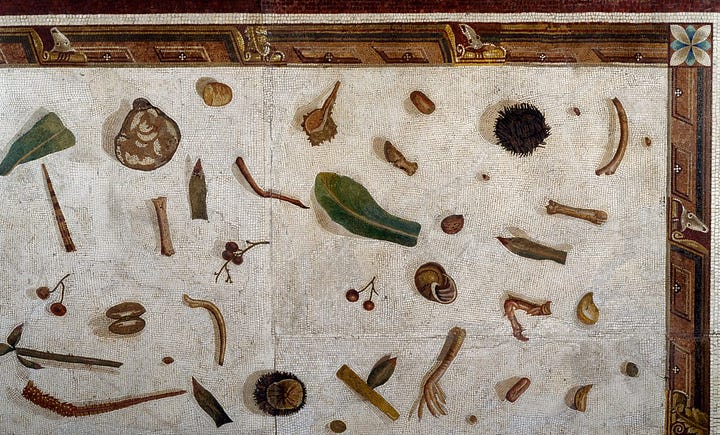

This 'all at once' style developed into a more labour-intensive and showier 'Service a la Russe' where courses were brought to the table individually and plate by plate. It was the norm in France and England by the late 19th century. The word dessert is thought to be derived from "desservir", French for 'to clear the table' and showed up sometime in the 17th century. At this point in history, the dessert would likely look unrecognisable to modern standards - while the availability of ingredients was one hurdle, the lack of refrigeration added another challenge to chefs. While some early refrigeration existed in the mid-18th century, and plenty of ice houses and huts existed as early as 400 BC (shout out to the Ancient Persians for eating and enjoying sorbet in at least 550 BC), it wasn't widely spread.
So, the visual appeal of dessert was often left to the inedible; Aesthetic spectacles were created with specially designed glass sculptures and table placements. The famous Chef de Cuisine / Patissier Marie-Antoine Carême was particularly renowned for his innovations in this area. French (bien sur), he was prolific in the 19th century for several culinary accolades, including his extravagant patisserie and sugar displays, the codification of the 'mother sauces' in typical French Cuisine, and he's even credited for the widespread adoption of the famous chef 'toque' hat.
Born to a poor family in Paris, he worked his way up as an apprentice in restaurants and bakeries in Paris and eventually catered Napoleon's wedding. After Napoleon's defeat, Carême became the in-house chef for Alexander I, the Tsar of Russia, during his occupation of Paris. Naturally, this meant a switch over to the 'service a la Russe' style. This didn't suit Carême, who apparently preferred the more sumptuous displays of the old French style that allowed him to create huge 'pièces montées' (centrepieces) inspired by his love of architecture, works of pure imagination. His first book, published in 1815, 'Patisserie pittoresque' is a collection of his edible centrepiece designs, which appear to me more like thinly veiled, unrealised architectural aspirations:
In a rather scathing biography in the Oxford Companion to Food, 1999, the writer suggests Carême may have been a 'conceited' man who wrote 'tangled prose' producing 'pretentious and heavy' food that was 'an extravagant waste of ingredients'. According to the same author, his instructions for the 'pièces montées' are 'sketchy.'
Either way, I'm thrilled to be finding my inner Carême with today's fanciful design and construction - meringue was just one of the mediums Carême and his chefs would use to create his masterpieces, which were likely only marvelled, never eaten. The major difference is I really want the whole thing to be edible.
What is old will become new…
I'm confident we're going to be seeing a lot more meringue sculptures in the near future. Of course, meringue as decoration is nothing new – little spiky kisses, shaped adorning cakes, or ghosts at Halloween have long decked the halls of Instagram. But standalone meringues as sculptures are having their moment as we head backwards? Forwards? Towards the fanciful, aforementioned pièces montées.
And it makes sense – the meringue is endlessly pipe-able and shape-able. It can be dried out to a crisp, affording structure to whatever artwork you've got planned (to a point… more on that below), as well as being able to capture intricate details and design. It's also… VERY edible. These are some of my favourite works of pastry art featuring meringue as of late by Rose Wilde and Süss Cake studio:
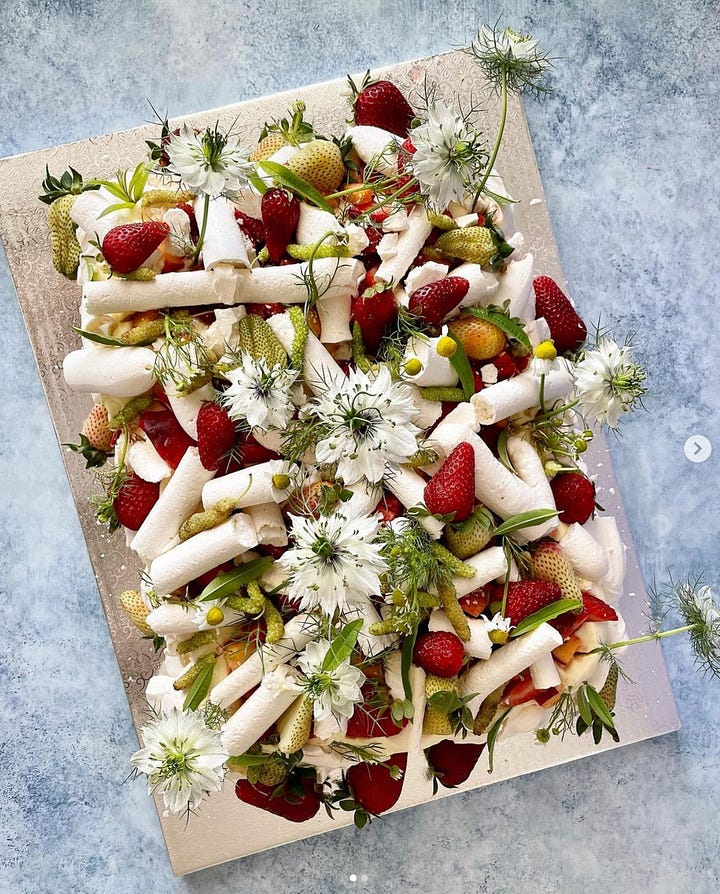
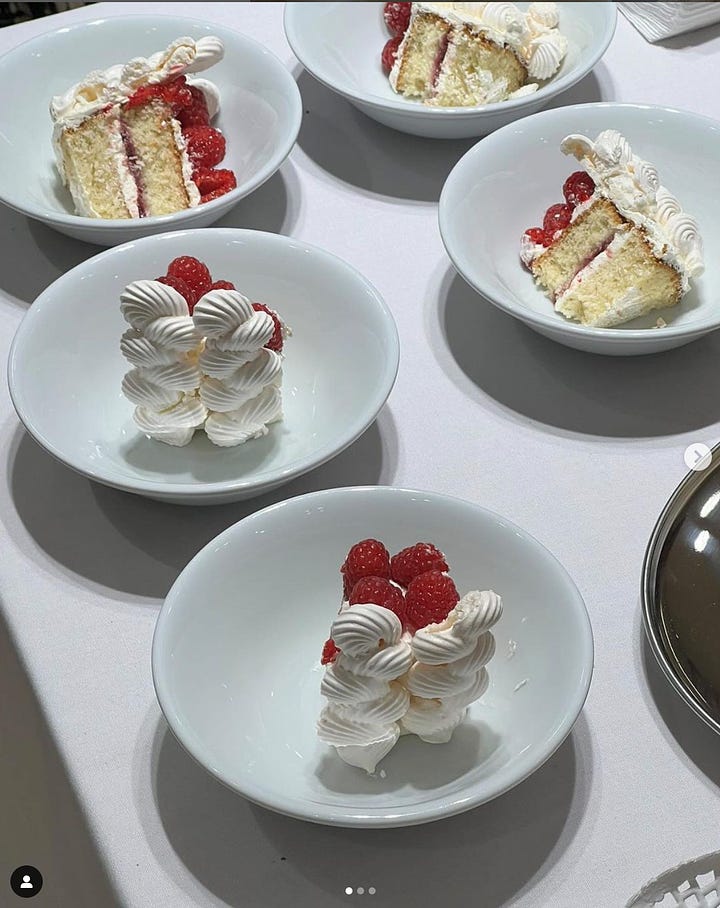
Meringue also suits the trend slide toward retro designs that we've seen take over the world of cake aesthetics of late. Where 'naked cakes' once stood, novelty-shaped cakes festooned with bright ruffles in clashing 80s hues are now the norm. It’s only natural that the next move in the time machine will be to the bright white, semi plastic-y cakes of yesteryear.
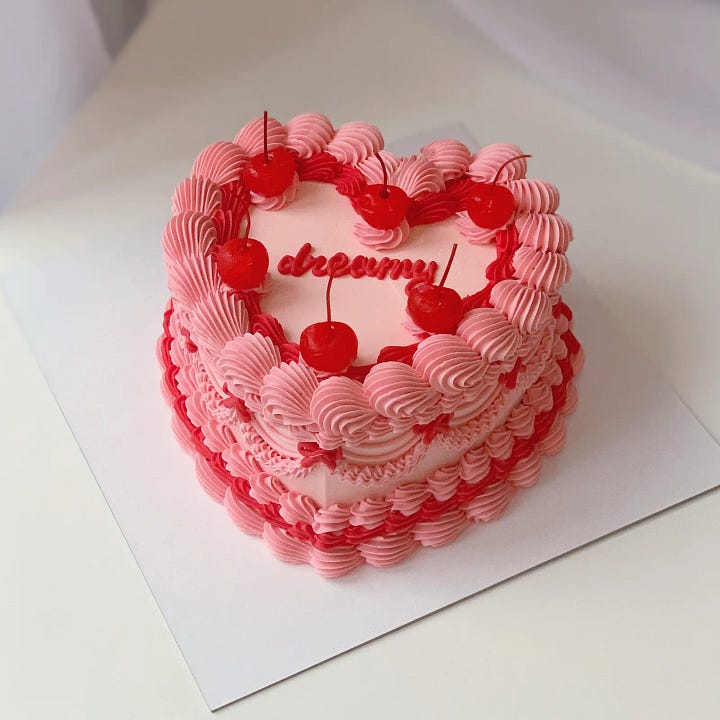

Meringue as a medium
These (soft) ruffles reflect the once-monocolour royal icing design once the height of sophistication and the cement of choice for cake construction. Meringue is certainly royal icing adjacent – they share ingredients (sugar, egg whites) at different ratios and are made with other techniques (meringue is strongly aerated, royal icing is slightly aerated), but both rely on the same process to dry out: Water evaporates leaving the hardened sugar and egg protein in place.
The trouble with meringue
Both royal icing and meringue can be victims of humidity. Sugar is highly hygroscopic, which means 'water-loving'. This means it will, at any opportunity, take on water from the environment and transform from crisp to sticky. This is why you'll notice some display cakes in bakery windows start to crumble and sag, the colours of the Disney princesses' faces beginning to run. This is less of an issue with royal icing, thanks to the very high ratio of sugar to egg white (10%), but often plagues meringue (50%+ egg white to sugar, usually), meaning it has less staying power. To help stability in your meringue, one of the best things you can do is to simply increase the sugar to egg white ratio. I would not do this for marshmallow meringues but it's essential for biscuitty dried-out building parts.
So, meringue sculptures should be assembled with care and with an understanding of their ephemeral nature. To a point, we use this hygroscopy to our advantage, letting the cream and meringue get pretty friendly and marshmallowy in the process, but this isn't helpful if we are looking at the meringue for structure. Plus, sticky meringue is unpleasant to eat. On the chew vs. stick spectrum, it's a fine line between being fun and miserable to eat. It is also precarious - once the meringue starts taking on the moisture from the environment or other ingredients, it's a quick slide to collapse. What was once a firm, dry scaffold is suddenly a bendy mess, dragging liquid from the fruit and cream along with it.
Fully dissolving sugar
Another challenge working with sugar, especially with meringues, is ensuring it is completely dissolved before proceeding with the bake. Unattached molecules invite water from the surrounding environment, which causes havoc later on. As I found out in my pavlova deep dive, a long mixing process will be enough to dissolve your sugar, but there is a trick to speeding this up: the 'French/Swiss fake out meringue.'
During my days at Ottolenghi, we made their famous meringues by warming the sugar in the oven before whisking it into the egg whites, combining the Swiss and French techniques. These meringues were always baked anyway, so the sugar heating was more of a stabilisation technique than a pasteurising or cooking technique. The heat of the sugar hastens its dissolving into the egg whites, and you are left with a robust and sturdy meringue without working your stand mixer to death.
The journey to the plinth
One of the reasons I love writing this newsletter is sharing the ups and (many, many) downs of recipe development, as well as the creative process that underpins the final look of a dessert. Sometimes recipes begin with an ingredient, or with a flavour, or with a feeling. But it's usually an organic process that ends with the plating. But sometimes, it begins with a full-blown concept, which means working backwards from the final look. A bit like the trifle showdown of 2022, this became a bit of a personal mission. Utterly impractical, but it NEEDED to exist in the world.
I also want to take this moment to thank everyone who was invested in this process on Instagram in the DM's; I got SO many brilliant ideas + helpful thoughts (and essential encouragement), so, thank you, thank you. I particularly loved a sketch by Shadie, putting his architecture degree to VERY good use, and I’m grateful to Olga for letting me know the structure I was creating was giving tholos, a form of round roofed building! Alright, let’s go through it:
Attempt 1:
It all began with the columns - the Greek ionic just lends itself so well to a couple of star tips. Shout to Alex Lewis in my DM's who said 'more like ICONIC columns.' Thank you. Thank you. I figured out how many columns I'd need with the classic 2π(r) and got to work.
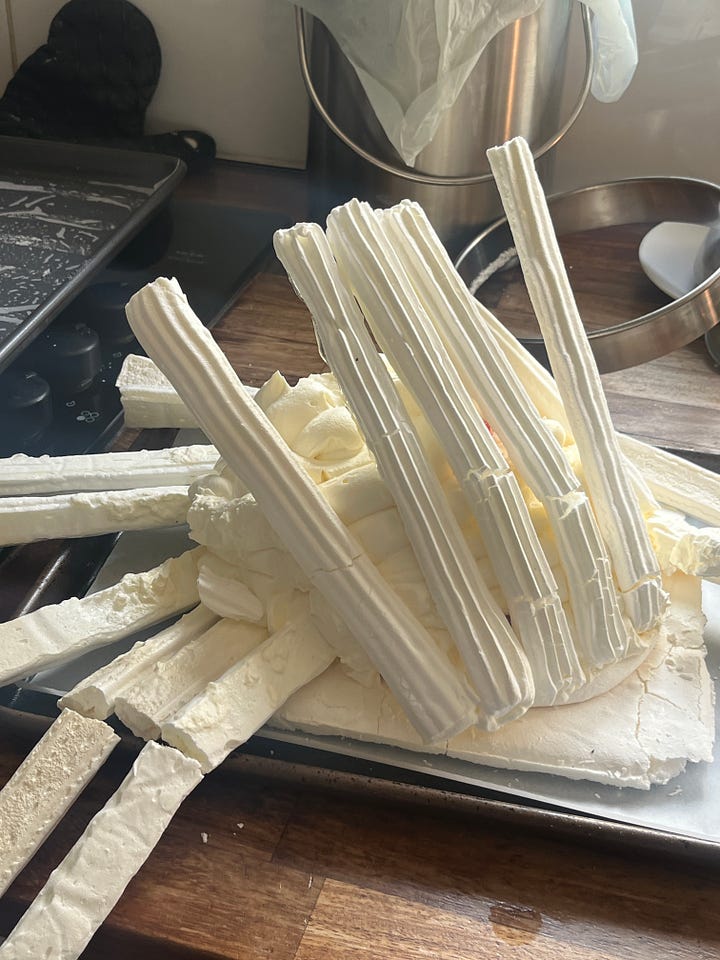

I'm not going to lie; the first attempt was rough. As you can see by my original sketch, I had delusions of grandeur. I was imagining a plinth well over a foot tall. Though I can now see that this was a very, very, very, very, very, misconstrued idea, I do look back on past me with affection - I mean, it *could* have worked… right? For this original design, I had conceived that over a foot of thick cream would be able to stand up on its own and support its own weight, and I'd simply stick my giant columns on, and voila, the fruit would balance on top. This definitely did not work, as evidenced here:
Attempt 2:
I radically slashed the size of the plinth, favouring stability over height. The columns were reduced from 15 inches to a more sensible 4 inches. It *sort* of worked, but it was too unstable. Though I like the hollow plinth looks for it’s multi-tier, Godfather wedding scene energy, it doesn't favour stability (don't worry, we'll return to that later). Definitely improving.
Attempt 3:
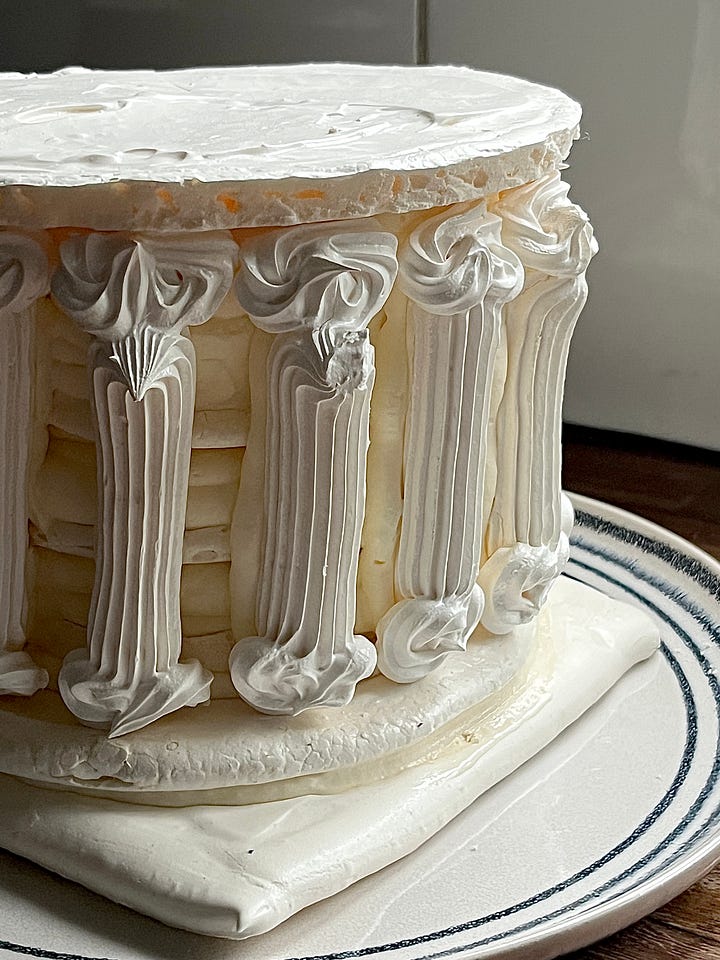

For my third attempt, which I hoped would be my final attempt, I piped a series of meringue discs in varying sizes and kept the columns to the 4-inch. The idea is to create a tower of alternating cream and meringue discs to create an internal structure (as well as being good to eat). To this, I affix the columns and, in theory, balance the slightly larger piece on top. Unfortunately, I made the top disc slightly too large and, in my attempt to resize the disc, created a hairline fracture in the meringue. Though it all started off great, and I was THRILLED with the look, the structure aggressively buckled under the weight. But I knew where I'd gone wrong and was satisfied with the construction, especially if I stabilised the cream. At the end of the day, if it DOES crumble, it suits what we're trying to depict anyway, right?
The final result: We did it! Four alternating layers of cream and meringue with a stable enough structure to hold a whole bunch of fruit. It was stable enough to hold a whole pear! But it for a fig in the end.
The construction held well at room temp for about 30 minutes, and it lasted an hour in the fridge before the hygroscopic nature of it created severe instability. I definitely think this is something that you want to decorate fresh. If you want to do any of it ahead, it is possible (outlined in the recipe) but not recommended. I also tried mini ones, which were less successful because they were sticky from humidity, but I’ll give them another go in the future.
BONUS: There were many VERY CLEVER people in the DM's who suggested I stick the columns back to back to create a 3D shape - I tried it, it's fantastic, I'm obsessed. Look at these! I used them to construct a pavilion-esque plinth:
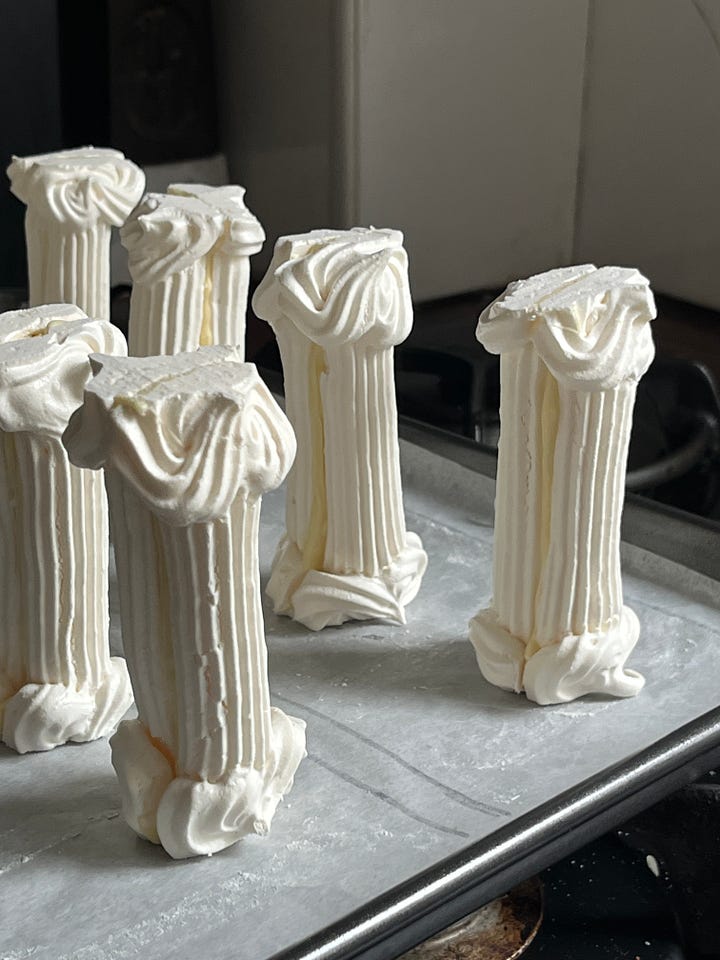



It's very sturdy with fruit on top, of course… reminiscent of version B. There's no obvious place to add cream, so this is more of a decorative work than a full-blown dessert, but I think the classicists and Careme will/would be proud. For something made with less than 5 ingredients, it makes a lot of impact.
Complete directions on constructing this are available for KP+ subscribers below, with details on the stabilising ratios, instructional GIFs, measurements & methods for best success! Can't wait to see what you all make! Go forth and conqueur those meringue domains! And please, let’s never ever ever stop creating!










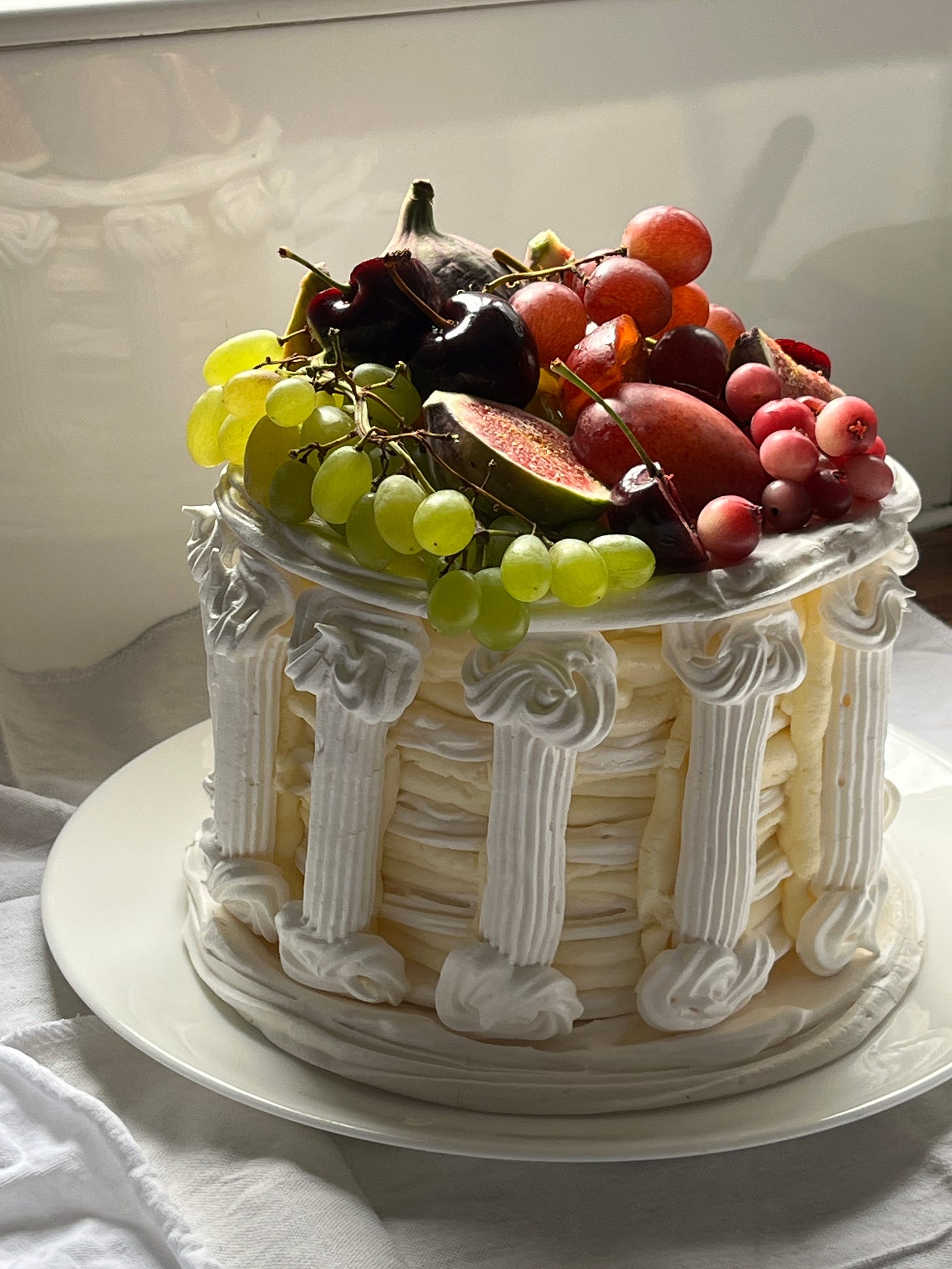

The classicist in me is more than slightly obsessed.
Bring back the meringue swan filled with mousse!